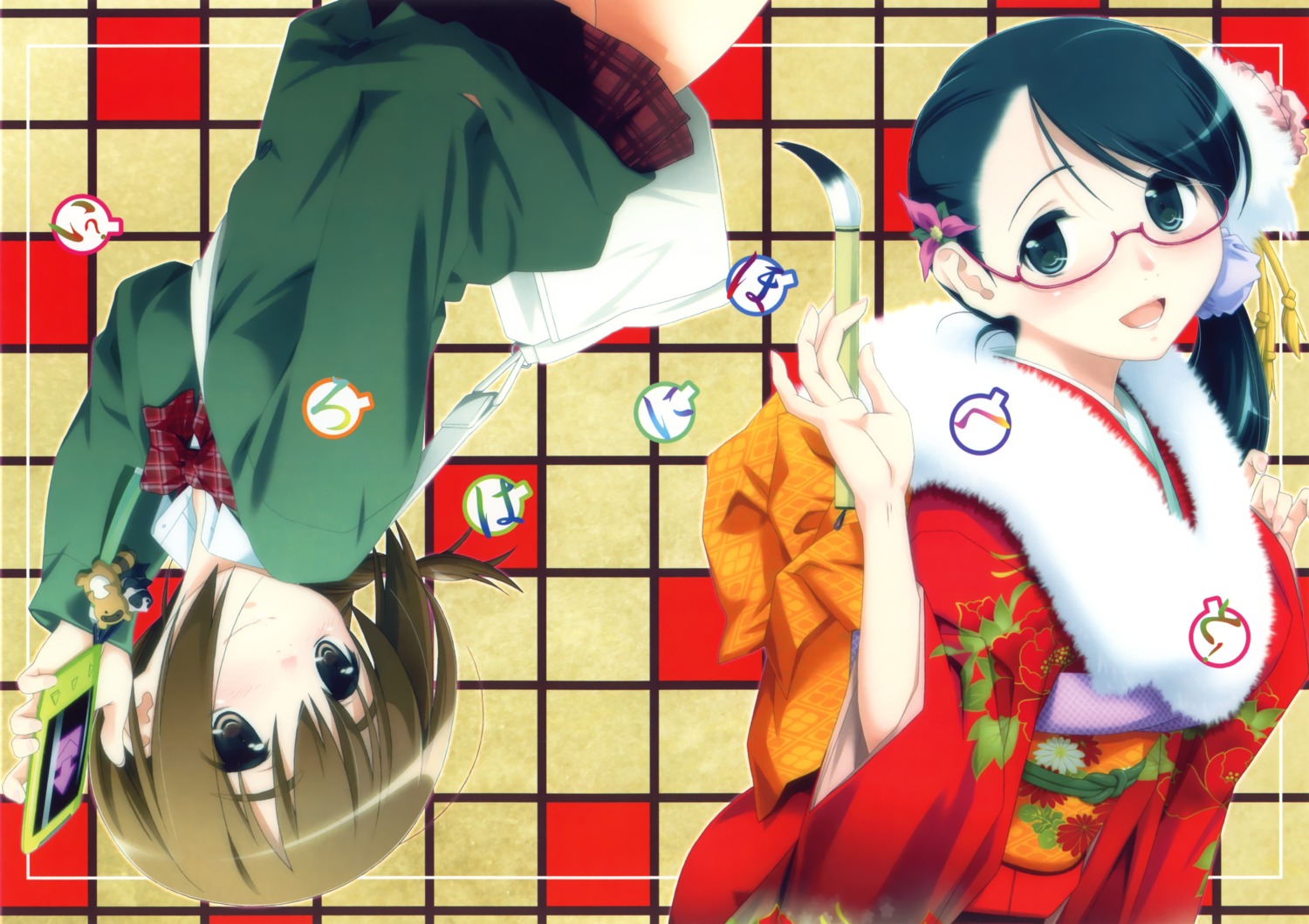This image has been resized. Click on the View larger version link in the sidebar for a high-quality version.
Hide this message.
« Previous Next » This post is #85 in the Eshi 100-Nin Ten 03 pool.
〇蜜柑
Marumikan
Fragrant Lolours
Fragrant Colours
「日本の一景」。さて何を描くか。一歩も海外に出たことのない自分には、「日本」はあまりに当然の環境。貧しい知識をかき集め、埃まみれの記憶を迪リ、Google先生Wikipedia先生にお尋ねし、万策尽きて机の周りを見回し……「これぞ日本!」なんてものは現代生活では存外なかったリ。和服も着ませんし2食に1食はパン。呆然と眺めたブラウザの画面に映る文字•文字•文字。名前の通リ漢字は輸入品ですが、加工しているうちに別物になっちゃったひらがな。輸入加工は日本のお家芸だそう。手塚先生だって、ディズニーから大影響を受けて今まで続くマンガの骨組みの1つを作リ上け'。マ一ジナルだったものが広まったってのもマンガに通じる?漢字とかなの関係を、マンガでの絵とセリフの関係になぞらえたり。古今〜スマホ。広がる妄想……そんな1000年以上前にできたものを、今時の女の子たちも使ってる、そんな「日本の一景」。いかがでしようか。
‘A Japanese scene’. What was I to draw? Never having set foot outside the country, ‘Japan’ was too natural an environment. Dredging up my limited knowledge, dusting off hoary memories, referring to professors Google and Wikipedia, I was at my wit’s end when I looked around my desk and realized that there was nothing in my daily life that was uniquely Japanese, that made me exclaim: ‘that’s it! That’s Japan!’ I never wear a kimono and I eat bread with half my meals, but gazing at the browser on my computer, all I could see was writing, writing, writing. Of course, as the name suggest, the Chinese characters came from China, but these were adapted in Japan to create a phonetic script— hiragana. Adopting and adapting things from abroad is a characteristic of the Japanese. Even the great manga artist, TEZUKA Osamu, was strongly influenced by the work of Walt Disney when he created the framework for the manga genre that exists to this day. Something that was initially marginal but later spread into general use shares a lot in common with manga. The relationship between Chinese characters and hiragana can be said to resemble that between the pictures and dialogue in manga. Past and present—smartphone. As my idea grew, I realized that something that was invented 1, 000 years ago was still being used by young girls today, and was therefore ‘a Japanese scene’. What do you think?
Marumikan
Fragrant Lolours
Fragrant Colours
「日本の一景」。さて何を描くか。一歩も海外に出たことのない自分には、「日本」はあまりに当然の環境。貧しい知識をかき集め、埃まみれの記憶を迪リ、Google先生Wikipedia先生にお尋ねし、万策尽きて机の周りを見回し……「これぞ日本!」なんてものは現代生活では存外なかったリ。和服も着ませんし2食に1食はパン。呆然と眺めたブラウザの画面に映る文字•文字•文字。名前の通リ漢字は輸入品ですが、加工しているうちに別物になっちゃったひらがな。輸入加工は日本のお家芸だそう。手塚先生だって、ディズニーから大影響を受けて今まで続くマンガの骨組みの1つを作リ上け'。マ一ジナルだったものが広まったってのもマンガに通じる?漢字とかなの関係を、マンガでの絵とセリフの関係になぞらえたり。古今〜スマホ。広がる妄想……そんな1000年以上前にできたものを、今時の女の子たちも使ってる、そんな「日本の一景」。いかがでしようか。
‘A Japanese scene’. What was I to draw? Never having set foot outside the country, ‘Japan’ was too natural an environment. Dredging up my limited knowledge, dusting off hoary memories, referring to professors Google and Wikipedia, I was at my wit’s end when I looked around my desk and realized that there was nothing in my daily life that was uniquely Japanese, that made me exclaim: ‘that’s it! That’s Japan!’ I never wear a kimono and I eat bread with half my meals, but gazing at the browser on my computer, all I could see was writing, writing, writing. Of course, as the name suggest, the Chinese characters came from China, but these were adapted in Japan to create a phonetic script— hiragana. Adopting and adapting things from abroad is a characteristic of the Japanese. Even the great manga artist, TEZUKA Osamu, was strongly influenced by the work of Walt Disney when he created the framework for the manga genre that exists to this day. Something that was initially marginal but later spread into general use shares a lot in common with manga. The relationship between Chinese characters and hiragana can be said to resemble that between the pictures and dialogue in manga. Past and present—smartphone. As my idea grew, I realized that something that was invented 1, 000 years ago was still being used by young girls today, and was therefore ‘a Japanese scene’. What do you think?

This post has 1 note
